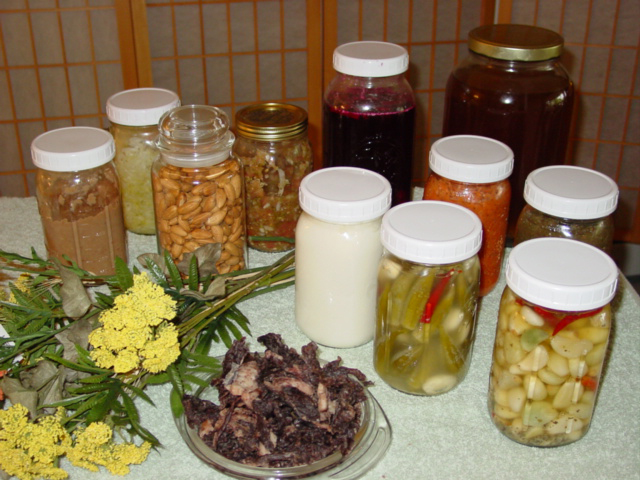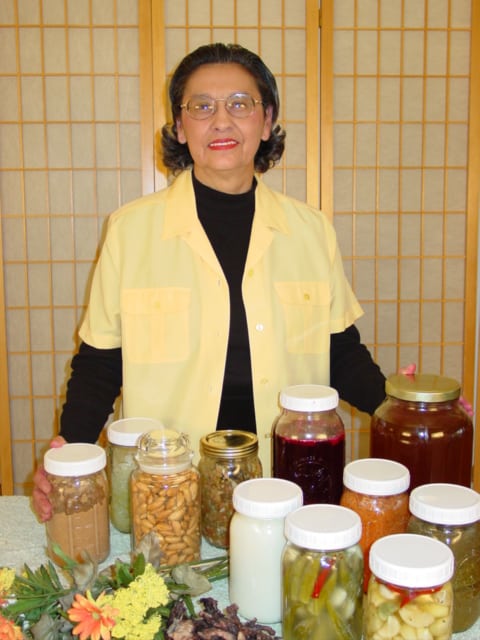So very much is now written about lacto-fermented foods that I honestly hesitate to bring the subject up yet one more time! Nevertheless, there are some basic facts that I hope will be new to many of you—and in turn propel you to take a long, hard look at the tremendous health benefits of these foods. I often wish I could just shout it from the rooftops and ask my clients and people in general to please add these wonderful foods to their already healthy diet. And definitely add them to an unhealthy diet!
Let me start by setting the record straight: lacto-fermented foods are not a fad. They’re here to stay. With the publication of Nourishing Traditions, Sally Fallon Morrell made fermented foods a household word. She rediscovered the power of our ancient ways and set out to change our 20th-century attitudes about food.
Our ancestors wouldn’t even recognize the food we eat today! And we can thank Mother Nature for that. After all, our ancestors had no viable refrigeration. Perishable foods were, by necessity, lacto-fermented so they would be available after the harvests. Or, as in the case of fresh, raw milk, some foods would only stay fresh a short time before beginning to culture or ferment. This was the only way to preserve them. Sadly, the marvelous, simple techniques of long ago were eventually replaced with refrigeration and chemical additives—resulting in the total destruction of living enzymes.
The natural bacteria that produce lactic-acid fermentation are destroyed in pasteurized and cooked foods, but are essential to maintain healthy intestinal flora and control acidity. Fortunately, while heat destroys bacteria, it doesn’t easily destroy lactic acid. Foods such as sauerkraut can be heated and still provide lactic acid.
Wonder foods that are fermented (not pickled in vinegar) may help protect against infections and fungi. Fermented foods and beverages also provide fiber, which aids digestion and could help prevent serious digestive disorders that may be the root cause of many illnesses. As described in Making Sauerkraut and Pickled Vegetables at Home by Klaus Kaufmann and Annelies Schoneck, the benefits of lactic acid are numerous. Here are just a few:
- Prevents decay, not only in food but in the bowels.
- Stimulates the peristaltic movement of the intestines.
- Assists in the circulation of the blood.
- Has a harmonizing effect on the stomach, strengthens the acidity of the gastric juice when production lags, and reduces acidity when production is up.
- Relieves the burden on the digestive system by significantly improving intestinal digestion.
- Increases nutrient absorption.
Along with the benefits of nourishing your internal organs, you should give lacto-fermented foods a daily try and see if you don’t feel the energy and goodness of using foods that are not just raw, but as Sally Fallon says in her many videos, super-raw. Good looks and youthfulness are a billion-dollar industry, but we struggle to keep our youthfulness using products that attempt to keep us younger from the outside in, instead of the way Mother Nature intended—from the inside out!
In my opinion, one of the most extraordinary benefits that comes only through the consumption of lacto-fermented foods is their ability to support our intestinal health. By consuming these foods, you provide your body with a steady supply of lactic acid. Everyone is born with indigenous intestinal bacteria (flora) that produces lactic acid whether or not we eat fermented foods. Cavemen who ate only meat produced lactic acid because of their indigenous gut flora. But because we consume substances—especially antibiotics and chlorinated water—that disrupt or even destroy our intestinal flora, fermented foods are essential to restore our gut flora and return our digestive health. We enhance and strengthen the creation of lactic acid by adding these foods to our diet.
When we keep our intestinal environment at the correct pH and provide lactic acid to feed our gut flora, our entire body is better nourished because our digestion is more efficient. Why wouldn’t we want to give our whole system a super-boost with a full-spectrum diet of living probiotics?
In my Cook Your Way to Wellness DVD and booklet, I teach you how to make your own probiotics, including kefir, and give you the most simple, detailed, and easy methods of making and adding these super-raw foods to your diet. No ads, no endorsements, just the plain facts! The fun part is that they’re relatively inexpensive to make—most fermented foods require no cooking. With these foods, you can impart the gifts of natural law each time you sit down to a meal.

The Benefits of Kefir
One of my favorite cultured foods is called kefir, which is best made using any form of full-fat milk. The milk chart in Cook Your Way to Wellness shows all the types of milk that are ideal for producing this nutrient-dense beverage. Many lactose intolerant people can drink kefir without a problem, as the milk sugars are removed through fermentation.
Besides kefir’s obvious probiotic value, it possesses other healing properties. Kefir grains produce a polysaccharide known as kefiran. Research in Japan showed a reduction in the size of tumors belonging to rats who were fed kefiran. It’s also said to have anti-inflammatory properties, according to the many accounts of people who have cured themselves of Crohn’s disease by drinking kefir and eating kefir grains (which have even been used rectally by some). In 2003, the anti-inflammatory effect of kefiran was investigated and scientifically correlated by Prof. Jose M. Schneedorf et al.
The Origins of Kefir
Kefir originated in the Caucasus Mountains. Legend has it that the prophet Mohammed made a gift of kefir grains to the Caucasus people, who then fiercely guarded the “Grains of the Prophet.” The Caucasus people were afraid they would lose their strength if the secret of kefir-making were to get out. But word of the “magical” properties of kefir spread. Marco Polo even mentioned it in his travels. Kefir was eventually forgotten for centuries, until news spread of its successful use in the treatment of tuberculosis, as well as intestinal and stomach diseases. The first studies on kefir were published in Russia at the end of the 19th century.
So how did kefir grains find their way to the rest of the world? According to this fascinating story, it’s said that the members of the All Russian Physician’s Society were determined to obtain kefir grains for their patients. To this end, the society approached the Blandov brothers, who not only had a dairy, but conveniently also had holdings in the Caucasus. The plan was for the brothers to procure a source of kefir grains and produce them on an industrial scale in Moscow. Nikolai Blandov hatched a plan to send a beautiful young employee, Irina Sakharova, to the court of a local prince, Bek-Mirza Barchorov. Her job was to charm the prince into handing over some kefir grains.
Though the prince was very taken with Irina, he was afraid to violate the religious law against giving away the Grains of the Prophet. When Irina and her party realized they would not complete the mission, they departed for Kislovodsk. Unfortunately, the group was waylaid by mountain tribesmen, who kidnapped Irina and took her back to the prince. It was a local custom to steal brides, so Irina was told that she was to marry the prince. Only a daring rescue mission mounted by agents of her employers saved her from the forced marriage. The unlucky prince was hauled before the Tsar, who ruled that the prince must recompense Irina for the insults she had endured—and the reward just so happened to come in the form of ten pounds of kefir grains. The kefir grains were taken to the Moscow Dairy and by September 1908 the first commercial kefir was sold.
Speaking of commercial kefir, this might be a good place to give a “buyer beware” warning. The kefir you buy at your local health-food store is not the same thing as fresh, homemade kefir.
The word kefir is derived from the Turkish word keif, which loosely translates to “feeling good.” This makes perfect sense as those who drink kefir regularly (myself included) claim it promotes a sense of wellbeing. So try making your own kefir and using it in one (or both) of the following kefir smoothies. These recipes meet the dietary guidelines of the Weston A. Price Foundation:
Peppermint-Carob Smoothie
Chocolate is not recommended by the Weston A. Price Foundation or Sally Fallon due to its excessive adrenal stimulation. This refreshing, minty smoothie calls for carob as a healthy and delicious alternative.
8–10 ozs. kefir
1 heaping tablespoon carob powder
¼ teaspoon peppermint extract
1 raw, pastured egg (optional)
1 tablespoon Standard Process Calcifood Powder
Stevia to taste
Any-Berry Smoothie
8–10 ozs. kefir
¼ cup berries of your choice
½ teaspoon pure vanilla extract
1 raw, pastured egg (optional)
1 tablespoon Standard Process Calcifood Powder
Stevia to taste
To make these smoothies, simply blend all ingredients together and enjoy. Recipes adapted from Natural News.



